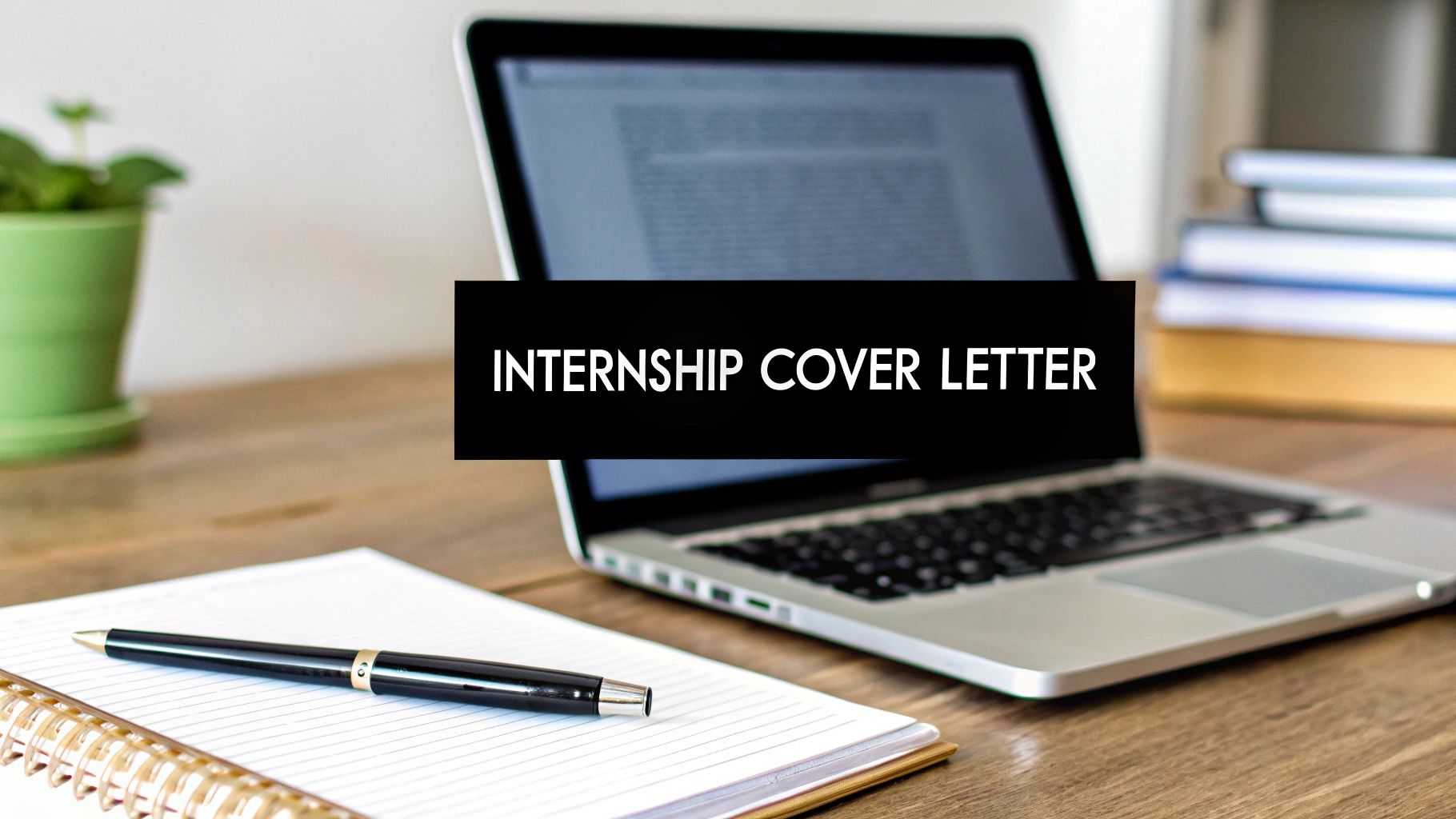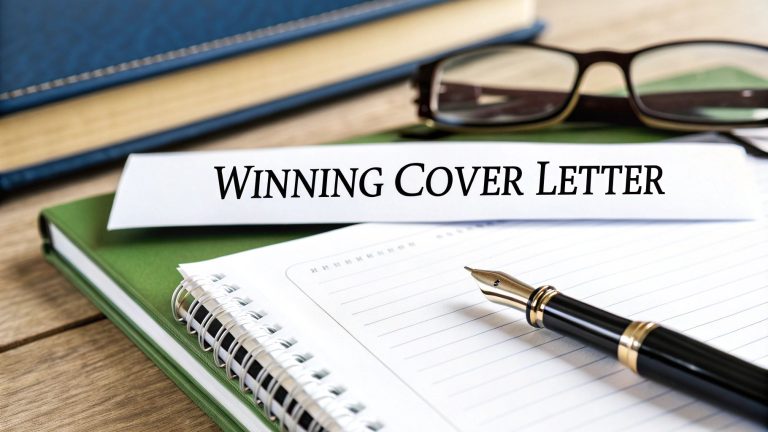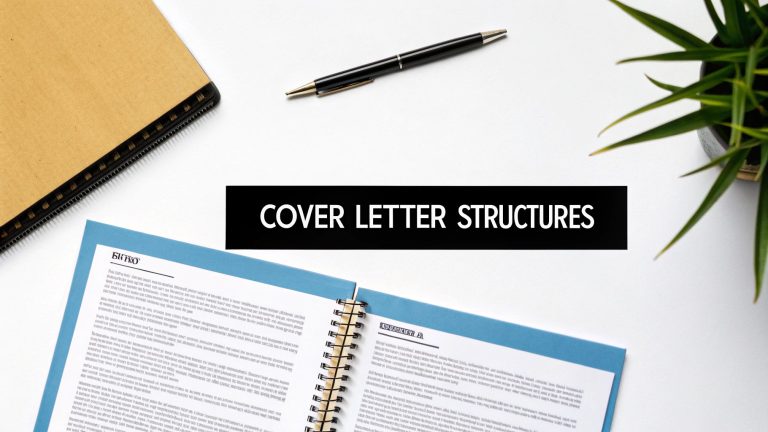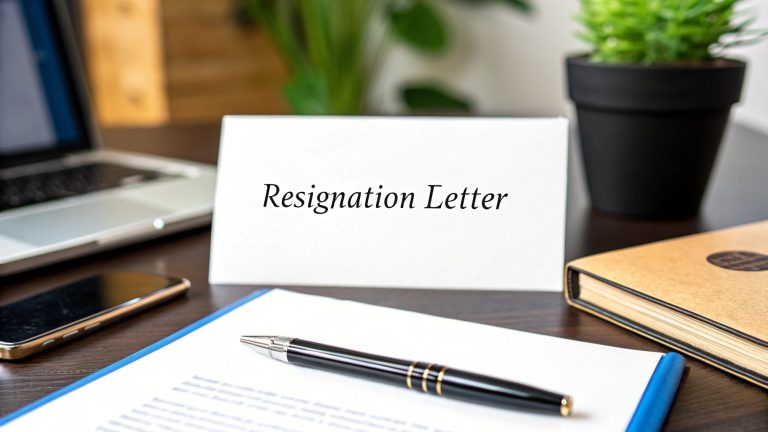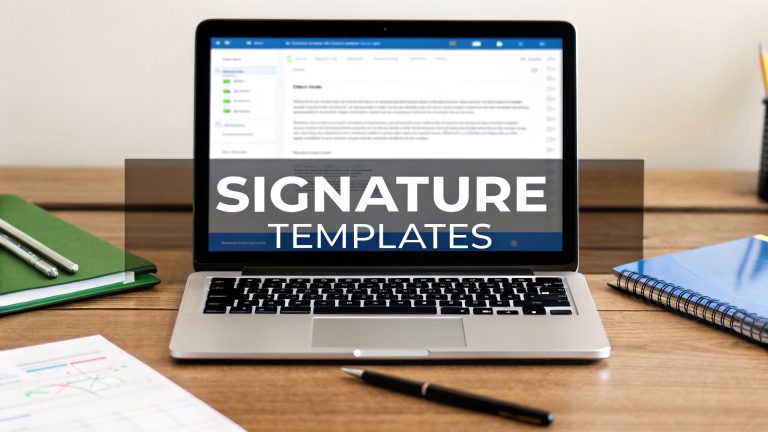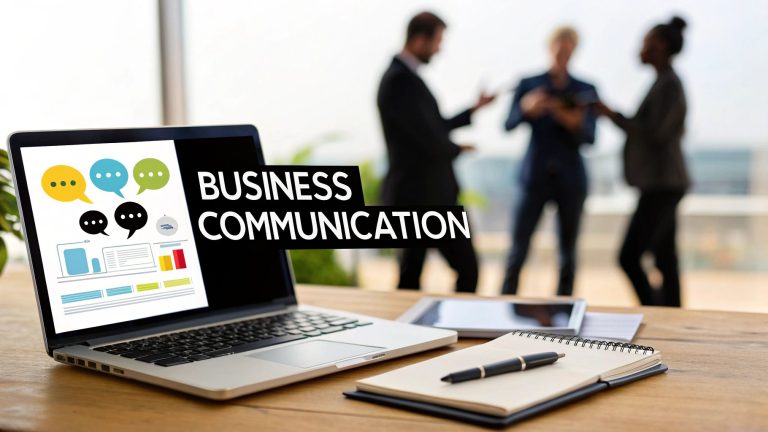Think of your internship cover letter as your first handshake with a hiring manager. It's not just a formality—it's your chance to tell the story your resume can't. This one-page document is where you explain why you're the right person for this specific internship and this particular company, connecting the dots between your experiences and their needs.
Your Internship Cover Letter Blueprint
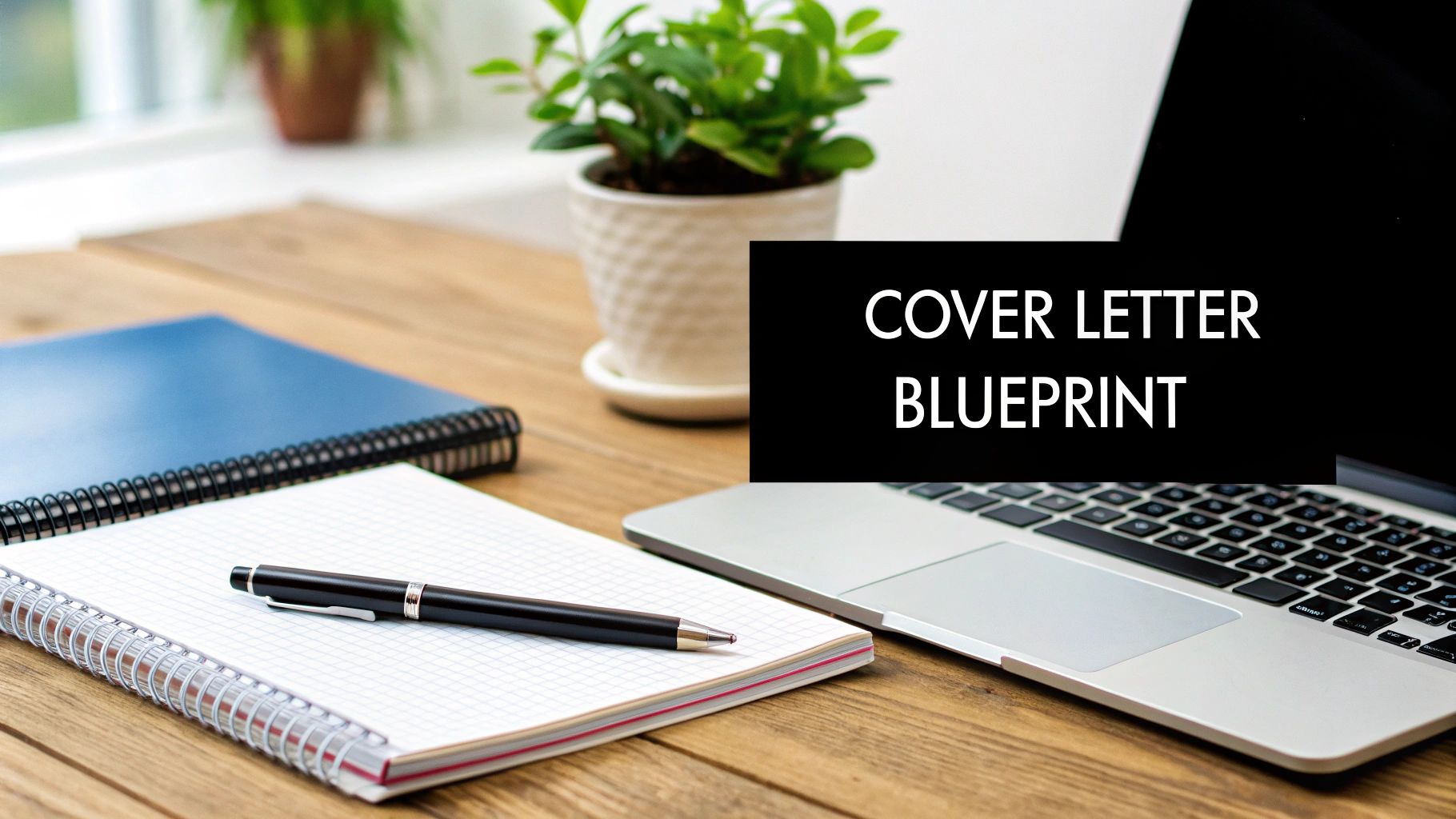
Stop thinking of your cover letter as a simple summary of your resume. Your resume lists the "what"; your cover letter explains the "why." Why are you so excited about this opportunity? Why do your specific skills make you a perfect fit? It’s your opportunity to build a real connection and move beyond a generic template.
This blueprint will break down the essential pieces that make a cover letter truly stand out. We'll go through what hiring managers are actually looking for, from a compelling opening hook to a closing that makes them want to schedule an interview.
The Anatomy of an Effective Cover Letter
Every great cover letter follows a proven structure. Once you understand the core parts, you can organize your thoughts and build a professional, polished argument for why you’re the best candidate. Each section has a specific job to do.
These key components are:
- The Header: This is where you put all the essential contact information—yours and theirs. Getting this right from the start shows you’re professional and pay attention to the details.
- The Introduction: A powerful opening paragraph that immediately grabs the reader's attention. Clearly state the role you’re applying for and hint at what makes you a strong contender.
- The Body Paragraphs: This is the real meat of your letter. Here, you'll draw direct lines between your skills, academic projects, and past experiences and the specific responsibilities of the internship.
- The Closing Paragraph: You need to end on a high note. Wrap up with confidence, reiterate your excitement, and include a clear call to action (like suggesting a meeting).
To see how these pieces fit together in different formats, it’s helpful to check out some cover letter structure examples.
More Than Just a Document—It’s Your Story
An internship cover letter is where you get to show some personality. It’s your shot at explaining your passion, proving you understand the company’s mission, and letting your voice shine through. This storytelling approach is a lot like what you'd do when learning how to write a personal statement that truly stands out.
The goal is to make a human connection. A hiring manager is far more likely to remember the student who shared a quick, relevant story about a challenging class project than the one who just listed their GPA.
To make this even clearer, here's a quick rundown of the essential components.
Essential Cover Letter Components at a Glance
This table breaks down each section of your cover letter, its main goal, and what you absolutely need to include.
| Section | Purpose | Key Information to Include |
|---|---|---|
| Header | Professional Formatting | Your full name, email, phone, LinkedIn URL, and the recipient's details. |
| Introduction | Grab Attention | The specific internship title, a key achievement, and your enthusiasm for the role. |
| Body | Provide Evidence | Examples connecting your skills to the job description and showing cultural fit. |
| Closing | Prompt Action | Reiterate interest, state your availability, and thank the hiring manager. |
When you treat your cover letter like a strategic blueprint, you shift from just listing facts to building a persuasive case for yourself. Each part works together to leave a professional, authentic, and memorable impression on the hiring manager.
Do Your Homework on the Company and Role

Before you even think about writing your cover letter, the real work begins. It’s the research. Honestly, a generic, one-size-fits-all letter is the fastest way to land your application in the trash pile. The secret to standing out is genuine personalization.
I'm not just talking about dropping the company’s mission statement into a template. You need to dig deeper. Get a real feel for their world—what projects are they excited about? What challenges are they facing? What kind of language do they use? This is how you prove you're not just spamming applications, but that you truly want to be there.
Go Beyond the Job Description
Think of the job description as your starting point, not the whole map. It tells you what they think they need. Your job is to read between the lines and show them you understand the bigger picture.
To get that context, you need to do a little digging. Here’s where I’d start:
- Company Blog & News Section: What have they been up to? Look for press releases, new product announcements, or articles about recent projects. This tells you what’s top-of-mind for them right now.
- LinkedIn Company Page: Don't just follow them—study them. Check out their "Posts" and "Life" tabs. This will give you a fantastic sense of their company culture and priorities.
- Team Members on LinkedIn: This is a pro move. Find the department you’d be working in and look at the profiles of people on that team. What skills do they list? What projects are they talking about?
Doing this lets you go from saying, "I have X skill," to something much more powerful, like, "I saw your team recently launched Project Y, and my experience with Z technology in my coursework could really help as you move into the next phase." See the difference? One is a statement; the other is a solution.
Understand Their Language and Values
Every company has its own vibe and vocabulary. When your cover letter subtly reflects their way of speaking, it sends a powerful signal that you’re already a good cultural fit.
For example, do they talk about being "scrappy" and innovative, or do they pride themselves on "data-driven excellence"? Weaving their own phrases into your letter shows you’ve been paying attention.
A truly great cover letter feels less like an application and more like the start of a conversation. By referencing specific company details, you’re showing you’re not just looking for any internship—you’re looking for this internship.
If their careers page is full of photos from community service events, mentioning your own volunteer work suddenly becomes incredibly relevant. It's not about just mirroring them; it’s about finding real, authentic connections between your story and theirs.
In a competitive market, this work matters. In some STEM fields, a single internship posting can get over 100 applications. Your research is what will set you apart. And don't forget, 26% of recruiters still say cover letters are an important part of their decision-making process.
Position Yourself as the Solution
All this research should lead you to one simple question: What problem can I help them solve?
Even as an intern, you’re there to add value. Maybe the marketing team is trying to figure out how to connect with a younger audience. Perhaps the engineering team is swamped and needs help with documentation for a new feature.
Your goal is to draw a direct line from their need to your skills.
- Their Need: "We're expanding our social media presence on TikTok."
- Your Solution: "As a digital native with experience creating short-form video content for a university club that grew its following by 50%, I am excited by the opportunity to contribute fresh ideas to your TikTok strategy."
This changes everything. You're no longer just a student asking for a chance; you're a proactive problem-solver who can deliver specific value from day one. This is especially critical if you're reaching out cold with a letter of interest instead of applying to a specific job. The core idea is the same: do your homework, find a need, and present yourself as the solution. An hour of research can make your letter ten times more effective and dramatically boost your odds of getting that interview.
Show Your Skills with Personal Stories
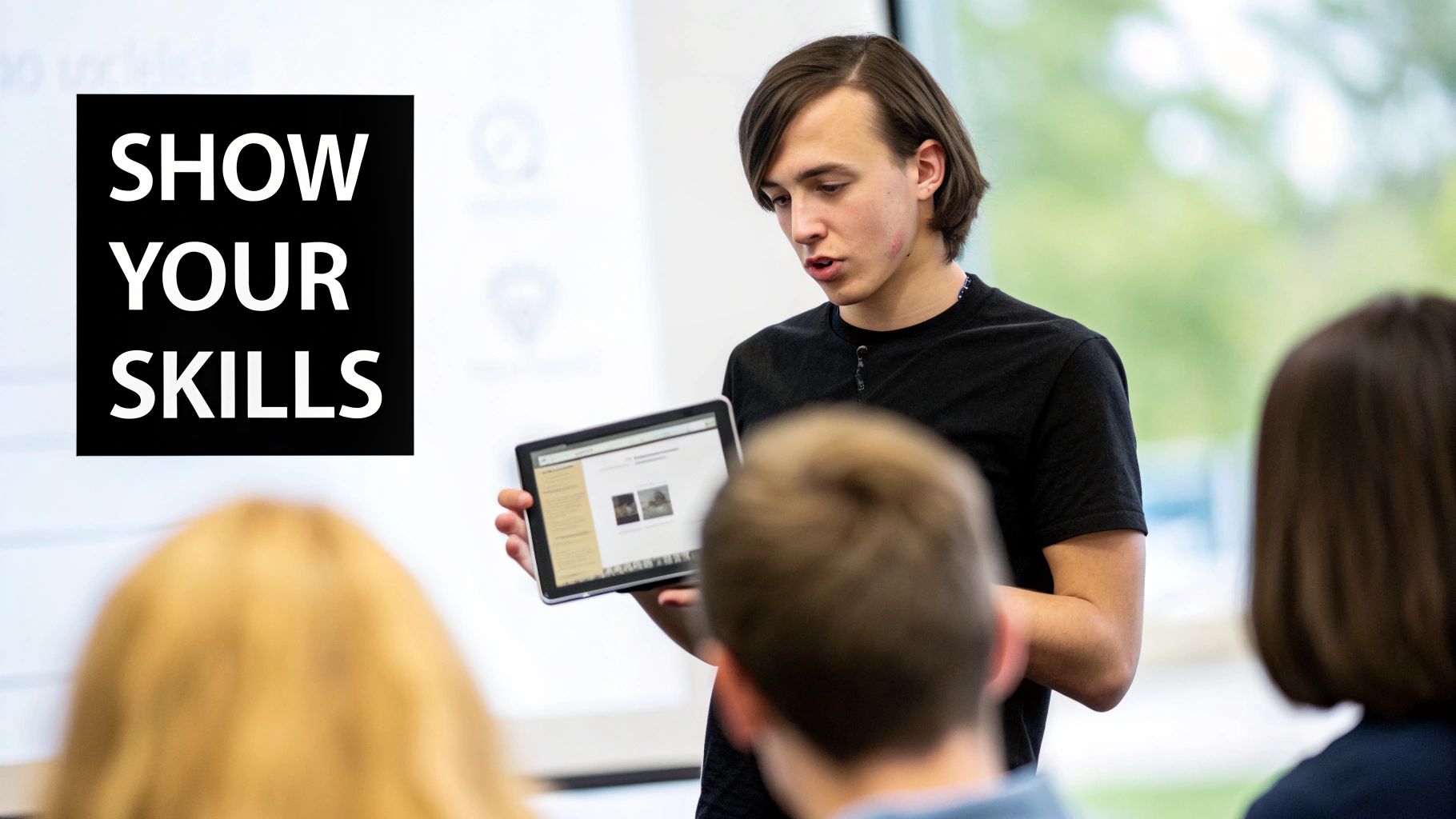
Anyone can write, “I have great communication skills.” The problem? So does everyone else. It’s a claim without proof, and frankly, it’s forgettable.
The secret to making your cover letter for an internship stand out is to stop telling the hiring manager you have a skill and start showing them with a short, powerful story.
Think about it from their perspective. They might read 50 letters in a single day. The ones that stick are the ones that paint a picture and make a human connection. A quick anecdote from a class project, a part-time job, or even a volunteer role can prove your abilities far better than a list of adjectives ever could.
A Simple Framework for Powerful Stories
You don’t need to be a professional writer for this. The best way to structure these little stories is by using the STAR method. It’s a simple framework that keeps your example clear, concise, and focused on what matters.
STAR is an acronym for:
- Situation: Briefly set the scene. Where were you? What was the context?
- Task: What was your specific goal or responsibility?
- Action: Describe the specific steps you took to handle the task.
- Result: What happened in the end? This is where you show off the outcome.
Using this structure stops you from rambling and forces you to connect your experience directly to the skills you want to highlight. It transforms a vague claim into solid proof of what you can do.
The STAR method isn't just a formula; it's a tool for translating your experiences into the language of professional achievement. It helps a hiring manager see you not just as a student, but as a potential colleague who gets things done.
Feeling like you don’t have any good stories to tell is incredibly common, especially when you're just starting out. If that sounds like you, our guide on writing a https://lettergenerator.co/cover-letter-no-experience/ can help you mine your academic and personal projects for skills you didn't even realize you had.
Turning Generic Claims into Memorable Examples
Let’s see how this works in the real world. So many applicants fall into the trap of using generic phrases that are essentially meaningless. Here’s how to fix that.
Before (The Generic Claim):
"I have strong teamwork and communication skills."
This is flat. It tells the reader nothing and does zero to set you apart from the dozens of other people saying the exact same thing.
After (The STAR-Powered Story):
"During my Intro to Marketing course (Situation), my group was tasked with creating a full marketing plan for a local startup, but we immediately hit a wall with conflicting ideas (Task). I scheduled and led a brainstorming session, making sure everyone’s perspective was heard, and then helped organize our best ideas into a single, cohesive strategy (Action). In the end, our unified plan earned us an A, and the professor even used our presentation as an example of great collaboration for the rest of the class (Result)."
See the difference? The "after" version is so much more persuasive. It doesn’t just claim communication skills; it shows you leading, resolving conflict, and delivering a successful outcome. That’s the kind of detail that makes an application stick.
Add Credibility by Quantifying Your Results
Whenever you can, add numbers to your stories. Quantifying your results provides concrete proof of your impact and makes your contributions feel much more significant. Even small numbers can add serious weight.
You don’t need to have managed a million-dollar budget to do this. Just think about your experiences in terms of simple metrics.
- Did you help a club grow its membership? By what percentage?
- Did you finish a big research project? How many sources did you analyze?
- Did you make a process more efficient at your part-time job? How much time did it save?
Here’s one more example:
Without Numbers: "I helped manage our club's social media and increased engagement."
With Numbers: "I took over our club's Instagram account and rolled out a new content strategy that grew our follower count by 20% and boosted average post engagement by 35% in just three months."
The second version is specific, credible, and way more impressive. It shows that you think about results—a quality every company looks for in an intern. To really nail this, make sure you understand what skills recruiters prioritize so you can tell the stories they want to hear. Weaving these brief, data-backed examples into your cover letter will turn it from a simple document into a compelling story of your potential.
Polish Your Letter and Perfect Your Tone
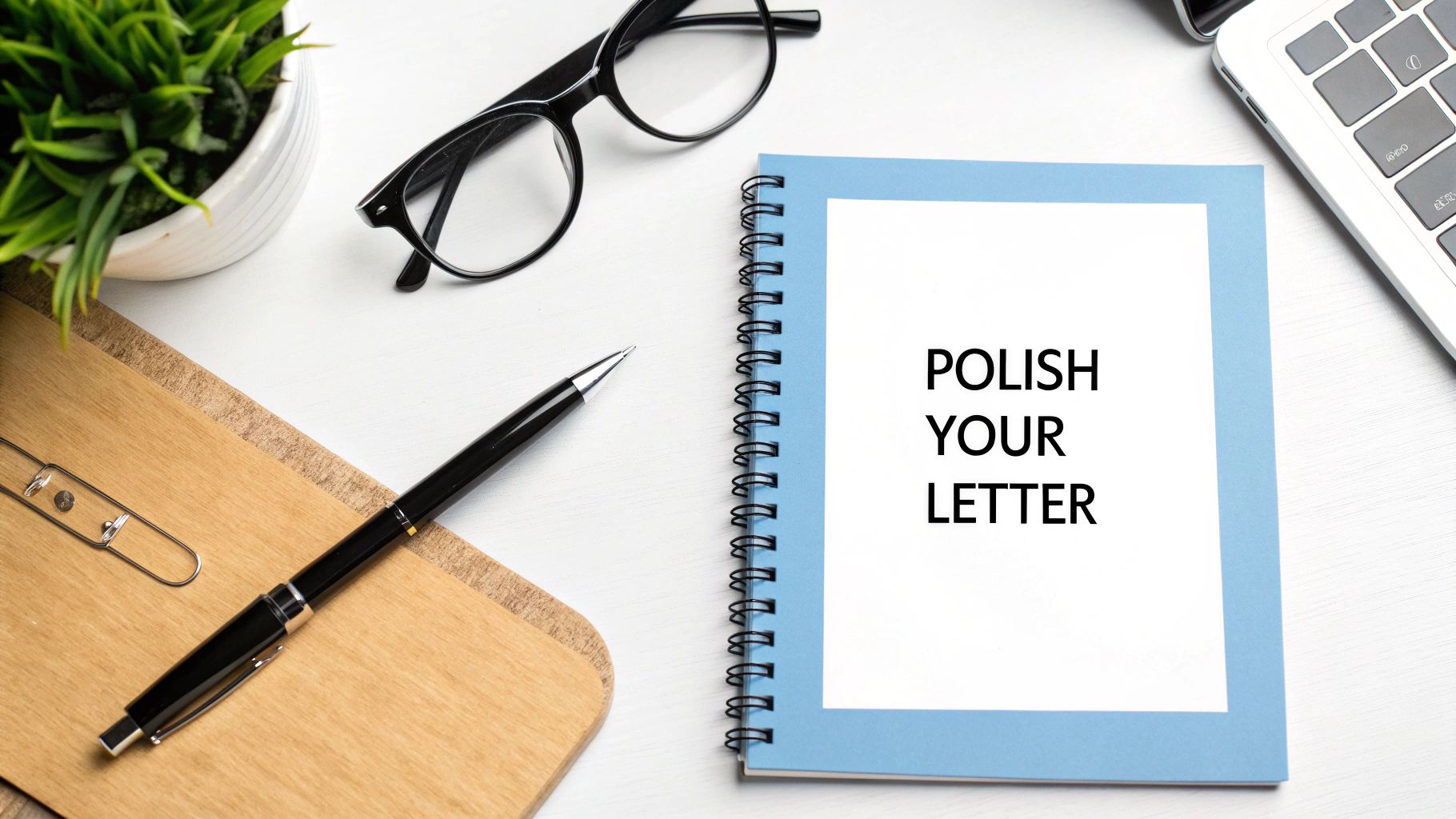
You’ve done the heavy lifting—researching the company, connecting your experiences, and telling a great story. Now it’s time for the final, crucial step: the polish.
How you say something is just as important as what you say. A single typo can completely undermine all your hard work. This last stage is all about nailing your tone and hunting down every last error.
Your cover letter needs to walk a fine line. It has to be professional enough to be taken seriously, but also show genuine enthusiasm for the role.
Finding Your Professional Voice
Your tone should project confidence, not arrogance. It should show excitement without being overly casual. A good rule of thumb is to imagine you're writing to a respected professor—you'd be clear and respectful, but you wouldn't sound like a robot reading a script.
A few things to keep in mind:
- Use the Active Voice. "I managed the project" sounds much stronger and more direct than "The project was managed by me."
- Pick Powerful Verbs. Swap out weaker phrases like "was responsible for" with words like "led," "created," "analyzed," or "achieved."
- Keep it Positive. Frame your letter around what you can bring to the table and how you hope to grow. Show them you're eager to contribute.
This balance is especially key in today's world of remote and hybrid work. Since your letter is one of the first impressions they'll have, a clear, professional tone proves you can communicate effectively, no matter where you are.
The Unforgiving World of Proofreading
Nothing sinks a great cover letter faster than a typo. To a hiring manager, a spelling mistake screams, "I don't pay attention to detail." If you can't get your own application right, how can they trust you with their projects?
Your final proofread is absolutely non-negotiable. And don't just rely on a spell checker. It won’t catch everything, especially common mix-ups like "their" versus "there."
A pristine, error-free cover letter is one of the easiest ways to demonstrate your professionalism. It’s a silent signal that you respect the reader’s time and take the application seriously.
To catch every mistake, you need a solid process. Don't just give it one last glance.
Effective Proofreading Strategies
Simply re-reading your letter on screen isn't enough. Your brain knows what you meant to write and will automatically gloss over mistakes. You have to trick it into seeing the words for what they actually are.
Here are a few proven methods I always recommend:
- Read It Out Loud: This is the single best trick in the book. Reading your letter aloud forces you to slow down. You'll hear awkward phrasing and catch typos your eyes might have skipped.
- Change the Format: Temporarily change the font, text size, or even the background color. This simple visual shake-up helps mistakes you've overlooked suddenly pop out. A clean, professional layout is also key; you can see our guide on how to format a letter professionally for more on that.
- Print It Out: Mistakes often seem to magically appear on a physical piece of paper. Grab a pen and mark up any changes you find.
- Read It Backwards: Seriously. Start with the last sentence and read your way to the top. This breaks the narrative flow and forces you to focus only on the mechanics of each sentence.
- Get a Second Pair of Eyes: Ask a friend, a mentor, or someone at your school's career center to read it over. A fresh perspective will almost always spot something you missed.
By taking the time to polish your tone and proofread like a pro, your cover letter for an internship will show you're the detail-oriented and enthusiastic candidate every company is looking for.
Let's See It in Action with a Real Example
https://www.youtube.com/embed/hrZSfMly_Ck
Theory is one thing, but seeing how it all comes together in practice is where the real learning happens. It’s the moment all the pieces—your research, your personal story, and a professional tone—click into place.
So, let's walk through a complete cover letter for an internship. Our fictional student, Alex, is applying for a Social Media Marketing Internship at a sustainable fashion brand called "Evergreen Threads."
Think of this not as a template to copy and paste, but as a case study. We're going to pull back the curtain and show you the why behind every single word choice.
Deconstructing the Introduction
First up, the opening. Alex has one shot to grab the hiring manager's attention and prove this isn't just another generic application.
Here’s how Alex starts:
"Dear Ms. Anya Sharma,
As a dedicated follower of Evergreen Threads’ mission to merge style with sustainability, I was thrilled to see the opening for a Social Media Marketing Intern on LinkedIn. My experience growing the Instagram presence for my university's Eco-Club by over 40% in six months aligns directly with your goal of reaching a younger, environmentally-conscious audience, and I am eager to bring my creative content strategies to your team."
Why this works so well:
- It’s personal. Alex addresses the hiring manager, Ms. Sharma, by name. Right away, this shows real effort.
- It shows genuine interest. Mentioning the company's specific mission proves Alex is a true fan, not just a job seeker blasting out resumes.
- It leads with a result. Kicking things off with a hard number (40% growth) makes an immediate, powerful impression.
Analyzing the Body Paragraphs
This is the core of the letter. It's where Alex has to connect their own experiences directly to what Evergreen Threads actually needs, telling a short story as proof.
Let's look at the first body paragraph:
"The job description emphasizes the need for someone who can create engaging video content. Last semester, I was tasked with producing a promotional video for a campus-wide sustainability initiative with a zero-dollar budget. By using my own equipment and teaching myself basic editing skills, I created a short, impactful video that was shared over 200 times and helped increase event attendance by 25% compared to the previous year. This experience taught me how to be resourceful and produce high-quality content that resonates with a specific audience."
This paragraph is gold. It uses the STAR method (Situation, Task, Action, Result) without sounding like a robot. Alex clearly shows they can solve problems, take initiative, and get things done—all things a manager desperately wants in an intern.
Now for the second one:
"I am particularly drawn to Evergreen Threads' recent #WearTheChange campaign. It brilliantly showcases how fashion can be a force for good, a principle I am deeply passionate about. My coursework in Digital Marketing has included a deep dive into audience analytics, and I am confident I could help analyze the campaign's performance data to identify key takeaways for future initiatives. I am proficient with tools like Google Analytics and social media scheduling platforms, and I am a quick learner with new software."
Here, Alex proves they’ve gone a step further by researching a specific company project (#WearTheChange). This isn't just surface-level knowledge; it demonstrates deep engagement. Plus, they smartly connect their academic skills to the company's real, ongoing work.
Nailing the Closing
Finally, the closing paragraph needs to leave a lasting impression, restate enthusiasm, and give a clear call to action.
Alex’s closing paragraph:
"My resume provides further detail on my skills and academic projects. I am incredibly excited about the possibility of contributing to a brand that is setting a new standard in the fashion industry. Thank you for your time and consideration. I am available for an interview at your earliest convenience and look forward to discussing how my skills can support Evergreen Threads' mission."
Sincerely,
Alex Chen
This ending is professional, confident, and polite. It clearly signals the next step—an interview—without sounding pushy or demanding.
A fantastic cover letter isn't just a hurdle to clear; it’s a strategic tool. Putting in the effort to craft a compelling cover letter for an internship is one of the most important first steps you can take in your career.
And that effort pays off. Internships are a huge advantage, as interns are nearly 25% more likely to land a full-time job within six months of graduating. For a closer look at the data, you can learn about the impact of internships on career readiness.
Common Internship Cover Letter Questions
Writing a cover letter for an internship can feel like you're trying to follow a set of unwritten rules. It's totally normal to have questions, especially when you're just starting your career. How long should it be? What do you do if you can't find the hiring manager's name?
Let's break down some of the most common things people wonder about.
One of the biggest hang-ups is always the length. You want to be thorough, but you also don't want to ramble. The key is to make a quick, powerful pitch.
How Long Should a Cover Letter Be?
Keep it short and sweet. The sweet spot for an internship cover letter is about half a page. That usually comes out to three or four punchy paragraphs, or roughly 250-400 words.
Think about it from the hiring manager's perspective—they're sifting through dozens, sometimes hundreds, of applications. A brief letter that gets straight to the point is a breath of fresh air. It shows you respect their time. Anything longer than a single page is almost certainly going to get skimmed, or worse, ignored.
Your cover letter is a teaser, not your life story. The goal is to give them just enough information to get them hooked and want to learn more in an interview.
Every single sentence has to earn its spot on the page. If a line doesn't directly add value or strengthen your case for the internship, be ruthless and cut it.
What if I Have No Relevant Experience?
This is easily the number one worry for students, but it’s not the dead-end it feels like. When you don't have direct work experience, the entire game is about showcasing your transferable skills. These are the skills you've picked up in other parts of your life that absolutely apply in a professional environment.
You have more experience than you think. You just need to know where to look for it:
- Academic Projects: Ever lead a team for a big class project? That's leadership and communication right there.
- Volunteer Work: Did you organize a bake sale or help manage logistics for an event? That shows project management and organizational chops.
- Part-Time Jobs: Working in retail or food service teaches you invaluable lessons in customer service, time management, and thinking on your feet.
- Personal Projects: Built a simple website or started a small online community for a hobby? That’s initiative and technical know-how.
The trick isn't just listing what you did; it's connecting the dots for the hiring manager. Don't just say you worked on a group project. Explain how managing deadlines and different personalities in that project prepared you to collaborate effectively on their team.
And once you've sent your application, the process isn't over. Knowing how to follow up politely is a crucial skill. A well-crafted email after an interview sample can make a huge difference in keeping you top of mind.
Feeling stuck staring at a blank page? The AI Letter Generator can create a polished, professional draft for your internship cover letter in seconds. Get your application started at https://lettergenerator.co.
